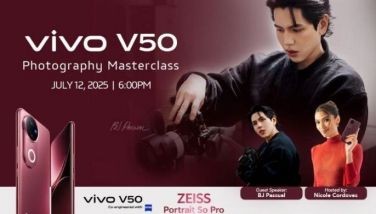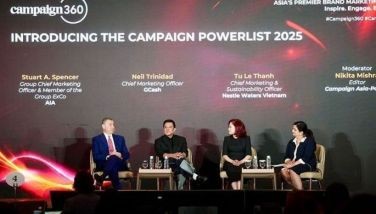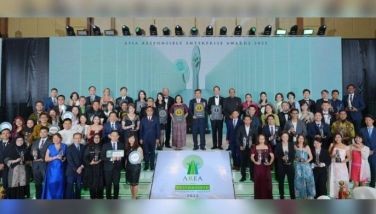A music photographer up close
What do Kanye West, Rivermaya, 30 Seconds to Mars, The Dawn, MUSE, Rain, Smashing Pumpkins, Katy Perry, Ely Buendia, John Mayer, Franco, Kings of Convenience and Cobra Starship have in common?
They’ve all been captured by the lens of Filipino music photographer, Niña Rosario Sandejas.
In 2004, she started as a stylist for local musicians such as Rivermaya and The Dawn. A year later, armed with her first digital SLR and a lot of guts, Niña started her career as professional freelance photographer.
One of the highlights of Niña’s career was to be chosen by JPG magazine as one of 22 photographers participating in their “Breakthrough” exhibit held at the San Francisco Arts Commission Gallery in 2007.
Niña Rosario Sandejas is one of On the Radar’s favorite photographers. We spoke to her recently to find out more about the person behind the lens.
ON THE RADAR: What makes a good or interesting photo?
 Self-portrait of music photographer, magazine columnist, fashion stylist and clothing designer Niña Sandejas
Self-portrait of music photographer, magazine columnist, fashion stylist and clothing designer Niña Sandejas NINA SANDEJAS: Generally an interesting photo showcases a different perspective on things. In my particular field, it’s the details that people in the farthest row of a concert don’t get to see, or visions that could possibly contribute in our almost non-existent chronicles of the local music scene.
Are you a self-taught photographer or did you have a mentor that showed you the ropes?
I could say that I’m self-taught, but most self-taught people get their information from somewhere. Technically it was guitar player Francis Brew who filled in the void of some questions I had about running a camera. It’s just like learning how to drive. With any skill, the opportunities that you take to apply what you learned is what really teaches you and I’ve got Rico Blanco to thank for introducing me to the music scene, which I knew nothing about nine years ago.
At what point did you evolve from a person who takes photos to a photographer and then an artist?
 Charice Pempengco getting ready to go onstage
Charice Pempengco getting ready to go onstage I don’t want to label myself. I’m aware that being in the creative field automatically brands you as an artist, but I accept it merely to conform to industry standards, to help people who view my work consider it a career option. Anybody can do this, which is what I keep telling everyone who expresses insecurity.
I don’t really think of myself as a photographer. A lot of people don’t know that many years ago I was passionate about illustration and painting, but with all amateur artists, encouragement is needed at the first sight of work.
I wasn’t criticized, but I felt that it didn’t have much effect on the people who were important to me at the time. I guess at a very early age, relevance was very important to me but the reactions would always come too late. It may be bold for me to say this now, but I still won’t show anyone my work until I feel that I’m ready.
Fashion was an offshoot of this, really. Colors and textures were laid out in front of me. In my research, I took to heart what Paul Smith does, where he shoots anything that can be used as inspiration, even if the photos aren’t that great. In the course of this, I realized that it was people, mostly musicians who inspired me. Fashion and music are two different things, but oftentimes inseparable, as one can inspire the other and vice versa.
 Ely Buendia has been featured in Niña’s monthly column for Pulp magazine called ‘One Hip Wonder’
Ely Buendia has been featured in Niña’s monthly column for Pulp magazine called ‘One Hip Wonder’ Documenting this relationship, or the lack of it, was something I started with and realized had an instantaneous effect on people, no matter how fleeting it may be.
What made you take the leap into professional photography? Was there a defining moment where you knew it was time to take pictures professionally or was there a gradual transition?
Being surrounded by musicians, you absorb their trait of discovering new and good music. I’ve been taking photos of musicians since 2003, but in 2007 I had my first international gig in Hong Kong covering Muse.
As a huge fan of the band, I could not say no. I realized I could travel and take music photos as a profession. A month later I toured with Rivermaya in Singapore, and have been documenting gigs professionally ever since.
What was that one fork in the road you wish you’d taken, just to see what it would have been like?
When Zara first opened here in Manila, they were looking for a window dresser. It was something that a lot of people would consider a fashionista’s dream job — no egos to deal with, just six-foot-tall mannequins. I passed several interviews, was trained by a Spanish window dresser, impressed the heads of Zara themselves who flew in from abroad.
 Rico Blanco’s last performance with Rivermaya
Rico Blanco’s last performance with Rivermaya I was already scheduled for a visa interview for training in Spain but apart from a professional reason, another door opened up which I felt was closer to my heart — to be part of the production of the first Pinoy Rock movie ever to be made.
After that my life has been about travelling and meeting world-renowned musicians, but I’ve always thought about the payoff and prestige of climbing the artistic ladder in a corporate setting had I chosen that path.
What makes you feel outraged or wanting to rant?
The ignorance of the local industry in recognizing music photography as a legitimate genre.
What is the most interesting thing you’ve done or worst thing you had to endure in the pursuit of photography?
The most interesting, the best and the worst thing I could have possibly allowed myself to do is falling in love with a subject. It really does wonders on what kind of photo you want to portray. Most people want them to appear larger than life, putting your subjects on a momentary pedestal, like a passing muse, can do that. Especially in my genre of photography, people look up to musicians as their personal gods. Although it doesn’t work for all subjects, there are people who are more transparent and predictable than others, which does not require a visceral take on things.




















